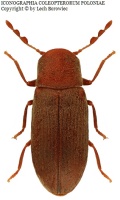Підтримуємо Вільну Україну
 We Support Free Ukraine
We Support Free Ukraine

Biodiversity Map
Taxa

Taxon count: 3
-
Arthropodaphylum
Click to switch
to select orders
and filters > -
Hexapodasubphylum
Click to switch
to select orders
and filters > -
Insectaclass
Click to switch
to select orders
and filters > -
Coleopteraorder
Click to set
as the main taxon
and as a base
← of the left panel > -
Polyphagasuborder
Click to set
as the main taxon
and as a base
← of the left panel > -
Bostrichiformiaseries
Click to set
as the main taxon
and as a base
← of the left panel > -
Bostrichoideasuperfamily
Click to set
as the main taxon
and as a base
← of the left panel > -
Ptinidaefamily
Click to set
as the main taxon
and as a base
← of the left panel > -
Anobiinaesubfamily
Click to set
as the main taxon
and as a base
← of the left panel > -
Gastrallinitribe
Click to set
as the main taxon
and as a base
← of the left panel > -
Gastrallusgenus
Click to set
as the main taxon
and as a base
← of the left panel >
PL
YES
name status: synonym
BioMap ID: 1016817
taxonomy checked: YES
valid name: Gastrallus laevigatus
Polish Red List: DD
source of names: Löbl et Smetana 2007
Data on distribution in Poland

Statistics
- Records: 22
- Publications: 13
- Collections: 1
- Publication authors: 10
- Illustrations (iconography): 1
- Photos (specimen/observation): lacking
Taxon description
Gatunek europejski, występujący głównie w krajach śródziemnomorskich, docierający na północ do środkowej Francji, Belgii, Holandii i południowych obszarów Europy Środkowej. W Polsce wykazywany przeważnie z pojedynczych stanowisk w czterech tylko krainach. Wzmianka J. Gerhardta (1895b), jakoby omawiany gatunek nie występował w Legnicy (Letzner 1889), jest niesłuszna, gdyż później (1898, 1910) ten sam autor wykazał go z Dunina koło Legnicy. Występowanie w polskich Beskidach Wschodnich winno być potwierdzone nowymi materiałami, gdyż dane o zasiedleniu okolic Przemyśla (Dominik 1955, Horion 1961) opierały się na wzmiance T. Trelli (1936), odnoszącej się jednak do terenu leżącego obecnie w Ukraińskiej SRR (Byków, Szechynie). Występuje na terenach nizinnych i pagórkowatych. Rozwija się w korze starych buków, dębów i wiązów; postacie dojrzałe wyhodowano również z jemioły pospolitej — Viscum album L. Chrząszcze ukazują się w czerwcu i są znajdowano do sierpnia.
Illustrations
... browse
 Gastrallus
Gastralluslaevigatus
External data sources
- Ostatnie rekordy
-
479840
 ×
× Ptinidae: Gastrallus laevigatus, PL, coll. ISEZ PAN
Ptinidae: Gastrallus laevigatus, PL, coll. ISEZ PAN -
180345
 ×
× Ptinidae: Gastrallus laevigatus, PL, «Galicja» (Łomnicki 1884a, Burakowski et al. 1986c)
Ptinidae: Gastrallus laevigatus, PL, «Galicja» (Łomnicki 1884a, Burakowski et al. 1986c) -
180344
 ×
× Ptinidae: Gastrallus laevigatus, PL, «Galicja» (Łomnicki 1874, Burakowski et al. 1986c)
Ptinidae: Gastrallus laevigatus, PL, «Galicja» (Łomnicki 1874, Burakowski et al. 1986c) -
180343
 ×
× Ptinidae: Gastrallus laevigatus, PL, «Prusy» (Lentz 1879, Burakowski et al. 1986c)
Ptinidae: Gastrallus laevigatus, PL, «Prusy» (Lentz 1879, Burakowski et al. 1986c) -
180342
 ×
× Ptinidae: Gastrallus laevigatus, PL, «Polska» (Łomnicki 1913, Burakowski et al. 1986c)
Ptinidae: Gastrallus laevigatus, PL, «Polska» (Łomnicki 1913, Burakowski et al. 1986c) -
126145
 ×
× Ptinidae: Gastrallus laevigatus, PL, «Śląsk» (Horion 1951, Burakowski et al. 1986c)
Ptinidae: Gastrallus laevigatus, PL, «Śląsk» (Horion 1951, Burakowski et al. 1986c) -
126144
 ×
× Ptinidae: Gastrallus laevigatus, PL, «Śląsk» (Kuhnt 1912, Burakowski et al. 1986c)
Ptinidae: Gastrallus laevigatus, PL, «Śląsk» (Kuhnt 1912, Burakowski et al. 1986c) -
126143
 ⊡
⊡ Ptinidae: Gastrallus laevigatus, PL, Beskid Zachodni, Cieszyn, UTM CA21 (Gerhardt 1910d, Burakowski et al. 1986c)
Ptinidae: Gastrallus laevigatus, PL, Beskid Zachodni, Cieszyn, UTM CA21 (Gerhardt 1910d, Burakowski et al. 1986c) -
126142
 ⊡
⊡ Ptinidae: Gastrallus laevigatus, PL, Beskid Zachodni, Cieszyn, UTM CA21 (Letzner 1889a, Burakowski et al. 1986c)
Ptinidae: Gastrallus laevigatus, PL, Beskid Zachodni, Cieszyn, UTM CA21 (Letzner 1889a, Burakowski et al. 1986c) -
126141
 ⊡
⊡ Ptinidae: Gastrallus laevigatus, PL, Beskid Zachodni, Cieszyn, UTM CA21 (Letzner 1871c, Burakowski et al. 1986c)
Ptinidae: Gastrallus laevigatus, PL, Beskid Zachodni, Cieszyn, UTM CA21 (Letzner 1871c, Burakowski et al. 1986c) - ... more
- Powiązane publikacje
-
Burakowski B., Mroczkowski M., Stefańska J. 1986c. Chrząszcze – Coleoptera. Dermestoidea, Bostrichoidea, Cleroidea i Lymexyloidea. Katalog Fauny Polski, XXIII, 11, Warszawa.
 Show records
Show records -
Horion A. 1961. Faunistik der Mitteleuropäischen Käfer. Band VIII: Clavicornia 2. Teil (Thorictidae bis Cisidae), Teredilia, Coccinellidae. Überlingen-Bodensee. XVI + 375 pp.
 Show records
Show records -
Horion A. 1951. Verzeichnis der Käfer Mitteleuropas (Deutschland, Österreich, Tschechoslovakei) mit kurzen faunistischen Angaben. 1-2. Stuttgart. X + 536 pp.
 Show records
Show records -
Łomnicki M.A. 1913. Wykaz chrząszczów czyli Tęgopokrywych (Coleoptera) ziem polskich. (Catalogus coleopterorum Poloniae). Kosmos, A, 38:21-155.
 full text
full text Show records
Show records -
Kuhnt P. 1912. Illustrierte Bestimmungs-Tabellen der Käfer Deutschlands. Ein Handbuch zum genauen und leichten Bestimmen aller in Deutschland vorkommenden Käfer. Lieferung 2-16. Stuttgart.
 Show records
Show records - ... more
- Powiązane zbiory
-
ISEZ PAN
 Show records
Show records




